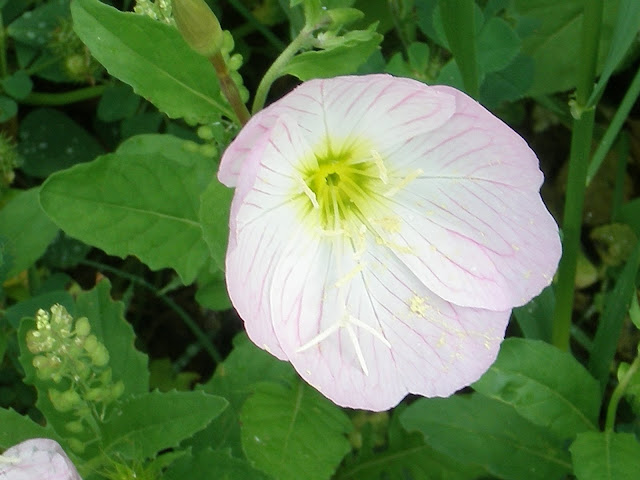My daily click on Schott's Vocab led to some strange connections. The phrase of the day is "the Ermintrude Effect," which refers to the embarrassment that some Britons feel when they eat their leafy greens. The column explains that Brits who munch awkwardly on watercress think they look like a cow named Ermintrude, a character from a stop-action animated children's show from 1970, called The Magic Roundabout, created by a fellow named Serge Danot and written and performed by Eric Thompson.
As you will see after you click below, Ermintrude is adorably zaftig. She wears a hat, bangs on a drum, and has a flower dangling constantly from her lips. She also has a palsy that causes her head to swivel madly and a voice that makes you wonder if all British men secretly wish they were women. The show itself has that relentless but creepy cheerfulness of Gumby or Davey & Goliath, shows that I only saw infrequently as a child because they so completely freaked out my steadfastly square mother. (For the record, so did Dr. Seuss books.)
I thought there might be some amusing connection that I could make to Dog Park, such as to Muzzy who gobbles fresh grass like a starving ruminant or to the dog character in the show, named Doogle, which looks like a dust mop and plays the straight man. But I could not because the clip is so unspeakably weird. Whimsical but definitely weird.
Enjoy. -z
Friday, April 23, 2010
Wednesday, April 21, 2010
Public Service Announcement
This is poison ivy. Study it, recognize it, avoid it. Last year, my Mum ended up in the emergency room with arms swollen like sated pythons. Don't let that happen to you!
I found this healthy specimen growing on a live oak right along the path by the creek. True fact: Global warming is poison ivy's friend. -z
I found this healthy specimen growing on a live oak right along the path by the creek. True fact: Global warming is poison ivy's friend. -z
Tuesday, April 20, 2010
Dog Is My Canvas
Photo credit: Suzy Allman for NYT
You know, one of the reasons I read the New York Times is that its sports section is different from every the other sports section on the planet. For example, instead of perusing an article about sweaty guys and the projectiles they hurl, catch, swat, or kick, I can read one about competitive dog grooming. This one even has a slide show. No kidding. You have to see these images to believe them. They are from a show called Intergroom. It is held in my home state of New Jersey, and apparently it is a really big deal.
Now, when I look at Muzzy, I am not inspired to creative flights of painterly fancy. Her palette is already pretty bold. But the many patient, light-furred poodles in this show served as muses and canvases both. Francesca, shown above, won second place. When she stood on her back legs, she looked, with her Easter-egg colored fur, like a sea horse. A man hid behind the shower curtain in the background and blew bubbles to perfect that special aquarium effect. Other dogs sported images of Elvis and Chinese dragons. One is a dead ringer for Johnny Depp as the Mad Hatter. It's cuter than Depp, but can it do an English accent that sounds like Keith Richards?
The dog below, who is not named in the article, won first prize for its owner, regular competition winner Angela Kumpe. Ponder it and then read the story to find out what it is all about and why it won over the judges.
Enjoy. -z
Photo credit: Suzy Allman for NYT
Monday, April 19, 2010
Sunday, April 18, 2010
What Is That Wildflower?
Several people have asked me lately what this particular wildflower is. For the answer, I went to my favorite resource, A Field Guide to Texas Wildflowers (UT, 1994) by Campbell and Lynn Loughmiller (with a forward by the godmother of Texas wildflower cultivation, Lady Bird Johnson). Here it is: Wild Honeysuckle (Bee Blossom). Latin name: Gaura suffulta.
I spent one spring a few years ago poring over that guide book trying to identify this flower. The book's photo only shows the blossom, not the rest of the plant, so it really took a while to make the connection. Folks have commented that they have never seen it before. It's a pretty unremarkable flower, at least compared to the showier bluebonnets, and so it is easily overlooked, except when it fills fields as it has this year. Even the wildflower experts call it "weedy."
When I told my friend Amy (Scooter) that the flower was called wild honeysuckle, she tasted it to see if it was sweet like the regular honeysuckle that grows on fences around Austin. Oops. It is not. Again, the Loughmillers say that the flowers are called bee blossoms because "their fragrance attracts honeybees." To the non-bee, however, they do not exude much scent.
Erica (Joey and Cocoa) and I were delighted to see this wildflower, one we did not recognize. It's pretty, no?
Well, I am sorry to say that it is the flower produced by the Tickclover or Beggar's Lice plant, the plant responsible for those horrible, fuzzy rice-grain-sized burrs that sticks to plants, people, and dogs alike.
Here's what the Loughmillers say about it: "The little tickclover plant, so pretty in the spring, can become such a nuisance in the fall. The seeds are detached at the slightest touch and cling tenaciously to one's clothing by the numerous tiny, hooked hairs." Like many other things in nature (kittens, for example), cute when young, snaggy and annoying when more mature.
Enjoy. -z
Subscribe to:
Comments (Atom)






















